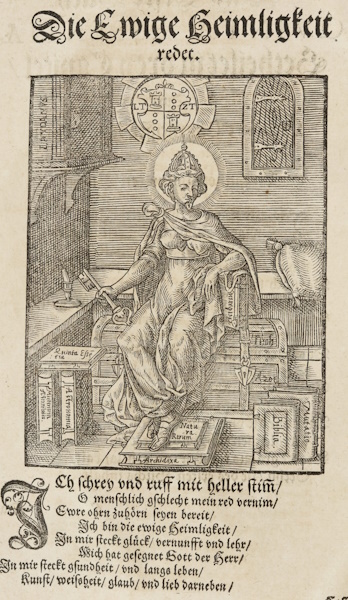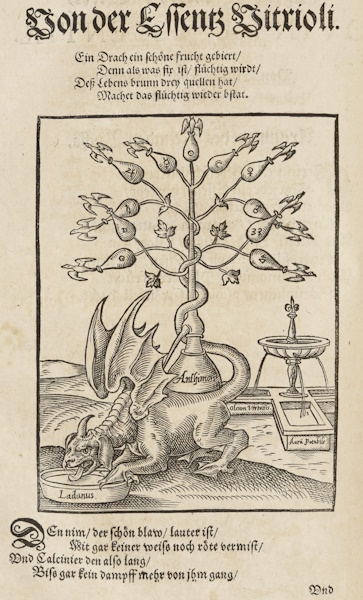There are plenty of treasures scattered throughout our rare book holdings, but we’re currently enamored with Leonhard Thurneisser zum Thurm’s Quinta Essentia, a wonderfully illustrated alchemical poem that’s a definite highlight of the Robert E. Schlueter Paracelsus Collection.
Like Paracelsus himself, Thurnheisser led an itinerant life. Born in 1531 in Basel, he learned the craft of goldsmithing from his father while also serving as an assistant to Johann Huber, a professor of medicine at the University. His tasks for Huber included gathering herbs and reading books aloud to him. This required reading may have included Paracelsus’s writings, planting the seed for Thurnheisser’s future Paracelsian leanings. He then left Basel to wander through Europe, serving in the army for a time before returning in 1555. However, he would not remain in Basel for long. He managed to involve himself in a scheme to pass off lead bars as gold, an event that forced him to flee his hometown, and he then spent time working as a goldsmith in Konstanz before moving on to Austria. His expertise in metallurgy caught the interest of the Archduke of Tyrol, and at the Archduke’s behest he went on research trips across Europe, supposedly going as far as Scotland’s Orkney Islands in one direction and Syria in the other. He eventually made his way to Berlin, where he established a laboratory and a printing press. But success was not to last. Back in Basel, a dispute with his wife resulted in his property being awarded to her, leaving him bitter. He ultimately died in Cologne, supposedly in the house of a goldsmith.
Thurneisser’s publications, which run the gamut from herbals to horoscopes, are often elaborate and even somewhat whimsical, with movable parts and large foldout pages. The Quinta Essentia is in some ways a simple book—no volvelles or liftable anatomical diagrams!–but it is still a delightful publication. In it, Thurneisser argues in favor of the mineral and alchemical remedies championed by Paracelsus, focusing particularly on “subtleties.” These were the powerful virtues that could be extracted from physical substances through alchemical means. Perhaps Thurneisser feared that this might make for dry reading, since he chose to write this particular work as a poem in order to make it more entertaining.
But while the poetic form is charming, the woodcuts are the real star. They portray allegories of alchemical themes and processes, satisfying the early modern love of puzzles and symbols. There are two examples included in this blog post. One of them shows the figure “Eternal Secrecy,” depicted as a female figure seated on a locked chest. Her lips are sealed with a padlock, and she is surrounded by various alchemical texts (a hint that the texts might be the key?). The other image introduces the chapter on the essence of vitriol. In it, a dragon drinks from a bowl marked “ladanus,” a substance that was often believed to be some sort of miracle cure. Meanwhile, his tail branches out into a tree bearing fruit marked with alchemical symbols—perhaps a sign of the ladanus’s potency.


This text is currently on display at Olin Library as part of the exhibit Secret Sciences: The Hidden Arts of Alchemy. Using materials from both Becker Library and the Julian Edison Department of Special Collection at Olin, this exhibit examines alchemy from several different lenses including art, science, and cryptography. Go and see it until January 21st, 2024!
Gantenbein, Urs Leo, “Thurneisser zum Thurn, Leonhard” in: Neue Deutsche Biographie 26 (2016): 232-234 [Online-Version]; URL: https://www.deutsche-biographie.de/pnd118622447.html#ndbcontent
Hofmeier, Thomas. Leonhard Thurneyssers Quinta Essentia 1574. Berlin & Basel: Leonhard-Thurneysser-Verlag, 2007.
Moran, Bruce T. “Art and Artisanship in Early Modern Alchemy.” Getty Research Journal, no. 5 (2013): 1–14. http://www.jstor.org/stable/41825343.
